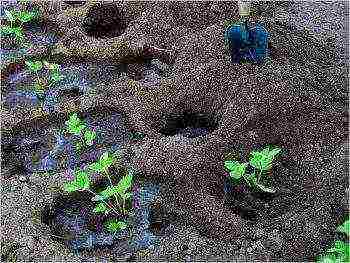Content
- 1 How to grow hibiscus from seeds
- 2 Planting hibiscus seedlings in open ground
- 3 Hibiscus flowers care
- 4 Diseases of the hibiscus flower
- 5 Soil for sowing hibiscus seeds
- 6 Planting capacity requirements
- 7 How to prepare seeds before planting
- 8 Sowing hibiscus seeds
- 9 Conditions for germinating seeds
- 10 Hibiscus seedling care
- 11 Seedling picking
- 12 Further care
Today I wanted to dwell on such a plant as hibiscus, or rather on growing hibiscus seeds... Many probably know that this plant is distinguished by its unpretentiousness. And unpretentiousness lies in the fact that hibiscus can withstand fairly severe frosts and drought. To plant hibiscus in open ground, you need to grow seedlings. But since the process itself is laborious, it will be somewhat difficult for novice florists. But if you approach this matter correctly and figure out what's what, then everything is not as difficult as it might seem at first.
How to grow hibiscus from seeds
First of all, you need to prepare the seeds, namely, soak them in a growth stimulator. This could be, for example, potassium humate... In order for the moisture to be evenly distributed, the seeds need to be mixed periodically. After the seeds are placed and wrapped in a damp cloth, and then in a bag. After a few days, germinated seeds can be observed. The next point is quite important, we pay special attention to it: we carefully take each seed and plant it in a separate container, for example, in a plastic cup. The soil for flowers is used as a primer, after which we cover the container with polyethylene. As a result, almost ideal conditions are created for growing hibiscus from seed... We place the containers in such a place so that the light falls on them, but there is no direct exposure to sunlight.
Planting hibiscus seedlings in open ground
Gradually, spring days are getting warmer. Seedlings will need to be taken outside for a short time, literally for a couple of minutes. Every day, we gradually increase the time spent on the open air. Thus, we temper her. The hardening period lasts about two weeks. We directly plant hardened seedlings in the open ground in the month of May, when there will be no fear of night frosts. Seedlings must be planted together with the soil from the cup. The distance between plants should be 30-40 cm. The place for planting should be well lit, since hibiscus grows very poorly in the shade. In the event that frost is still possible after planting, then you need to take care of the shelter of the seedlings. Probably the most common is polyethylene.
Hibiscus flowers care
Caring for your hibiscus shouldn't be too much of a hassle for you. It actually consists in loosening the soil, as well as in regular watering. It will not be superfluous to feed hibiscus mineral fertilizers... This is especially necessary during early spring. After all, it is then that the rudiments of our future flowers are formed. To give hibiscus a neat appearance during flowering, you need to monitor and remove dried flowers. This applies both to flowers on the bush and to those that have already fallen off. Since hibiscus normally tolerates negative temperatures, it is not necessary to cover it for the winter. If we are talking about young plants, then mulch they are not needed in the first year of planting. It is better to pay attention to this in the following years after planting, i.e. when the flower is already strong. As mulch, you can use peat, humus or straw with a layer of 5 cm.In general, you can learn more about mulching and the materials used from the article given.
Diseases of the hibiscus flower
The most commonly observed hibiscus chlorosis, which manifests itself in the yellowing of the leaves. For preventive purposes, as well as in case of manifestation of the disease, the leaves are sprayed with a solution of iron chelate. By the way, iron chelate can be prepared at home quickly enough. The solution should only be used fresh, as it loses its quality over time. For cooking, you need citric acid 2.5 g and 4 g ferrous sulfate... Dissolve iron vitriol in 1 liter of distilled water, add citric acid. The spray solution is ready. In order for the hibiscus to bloom before it will need to be fed with flower fertilizer. Today their choice is huge. If you overdo it with nitrogen fertilizers, the plant will have lush foliage but no flowers. That's all that I wanted to tell about growing hibiscus seeds.
My courtyard
Hibiscus is often called the flower of love. It is distinguished by its beautiful exotic "appearance" with flowers of different colors. They can be white, blue, red, purple, yellow. To date, more than 200 plant varieties are known. In Russia, only Syrian tree hibiscus can grow. The rest of the varieties are even more fond of warmth and moisture, so it is very difficult to grow them here. We will now talk about how to grow garden hibiscus from seeds, its planting and care. By the way, the flower is completely unpretentious to care for.
The best time to plant a plant is spring. This can be done in several ways. Cuttings and seeds.
- If you grow with seeds, then the process should start in winter. Take seeds and soak in epin solution for ten hours.
- Pour peat and sand in equal amounts into the container. Moisten a little and plant the seeds, it is best to keep the seedling pot warm. Remember to water and spray frequently.
- After sprouts appear, immediately plant them in separate containers.
- As soon as the cold ends, plant in open ground. Choose a sunny spot for planting.
We have already said that this is not the most capricious plant. How to care for a green pet?
- To make the plant happy with abundant flowering, prune its bushes several times a year.
- The soil for planting must be fertile and permeable.
- Plant lavender next to it, this way you will save the hibiscus from aphids.
- To make the flower bloom magnificently, feed it twice a year with phosphorus fertilizer.
- For wintering to pass with a bang, feed with fertilizer with a high potassium content.
- Never flood the plant with water. Water when the ground is dry.
- It is best to plant the plant on the sunny side. It will, of course, grow and bloom in the shade, but the flowers will be small and pale.
- Do not forget that the flower is tropical, spray it with water constantly.
If you care for a flower correctly, then it can delight you for 20 years.
A few tips:
- The plant may lack fertilizer or water if the flowers open and fall off immediately.
- The lower leaves may fall off, and the upper ones turn yellow, if the water for irrigation is poor.
- Sluggish leaves are insufficient watering.
- If the roots dry up, then the flower is growing in cold soil. Transplant to a warmer location.
Hibiscus gets along well with its neighbors, especially roses.
Growing hibiscus seeds requires patience and a lot of work, but the reward for the work will be a self-bred variety that only you will have. This article will tell you about pollination of plants, about the maturation of seeds, about preparing them for sowing, as well as how to care for the resulting seedlings.
The first stage is pollination
How to properly pollinate a plant to get seeds?
You will need two different varieties of flowering hibiscus. It is desirable that they be bright in color, large-flowered.
Take a cotton ball and rub it gently against the anthers of one of the flowering hibiscus. With the resulting pollen, it is good to blot the stigmas of the pistil of another flowering specimen, which will bear the seed capsule.
It is best to take a non-terry hibiscus variety as a mother plant, since terry varieties very rarely set seeds.
The second stage is seed ripening
The seed pod, which is covered with sepals, begins the plant after the flower petals fall off.
If there are buds on the mother plant at the same time, then their formation will slow down a little, and the plant itself will slightly suspend growth, since all forces will be thrown into the maturation of the seeds.
On average, it will take 2-3 months for the seeds to ripen.
When the seed pod darkens, do not miss the picking point. Otherwise, when the capsule opens, the seeds may crumble.
Seed capsule
Seed preparation for sowing
In order for the seeds to germinate better, they must be scarified, i.e. violation of the integrity of the shell, followed by soaking.
Take the sharpest possible knife and carefully cut the flat part - a thin layer of skin - from the "back" of the seed.
You can try another method that collectors use.
A large container must be lined from the inside from the inside with sandpaper - an abrasive surface inward. Place the seeds in it, cover and shake vigorously for several minutes. As a result, the seed coat will be scratched and when soaked, they will swell and germinate faster.
Freshly harvested seeds have good germination and do not need scarification.
Before planting, the seeds must be soaked for 2-5 hours in a solution of zircon at the rate of 4 drops of the drug per 1 liter of water. But you can use another remedy: for 1 glass of water - 1 tsp. honey and 1 tsp. aloe juice.
Hibiscus seeds
Sowing seeds
The best option is to sow each seed in a separate container, for example, in disposable plastic cups.
Substrate should be light and airy with the addition of a sufficient amount of perlite (1: 1).
Seeds are sown to a depth of 3-5 mm in moist soil and placed in a greenhouse.
Note for yourself the mother plant on which the capsule ripened and the specimen from which you took the pollen.
Hibiscus seedlings
Seedling care
When young hibiscus has 2-3 pairs of true leaves, they gradually begin to accustom them to indoor conditions.
Seedlings are quite sensitive to both bays and dry soil.
Transplanting into a larger pot is carried out with a well-developed root system.
Pay attention to the lighting. In summer, as a rule, there is enough lighting, and in autumn and winter it is worth taking care of additional lighting so that the plants do not stretch out from lack of light.
Be sure to rotate the pots in relation to the light source once a week so that the stems form even.
Young plants are fertilized at the same frequency as adult specimens, but the fertilizer concentration should be half as indicated on the package.
Hibiscus (Chinese rose) is a houseplant that blooms from early spring to autumn with proper care. The plant has large inflorescences of various shades; at the moment, dozens of varieties have been selectively bred, suitable for planting in open ground and at home. The Chinese rose is a symbol of financial well-being, large flowers mean prosperity and wealth.
Soil for sowing hibiscus seeds
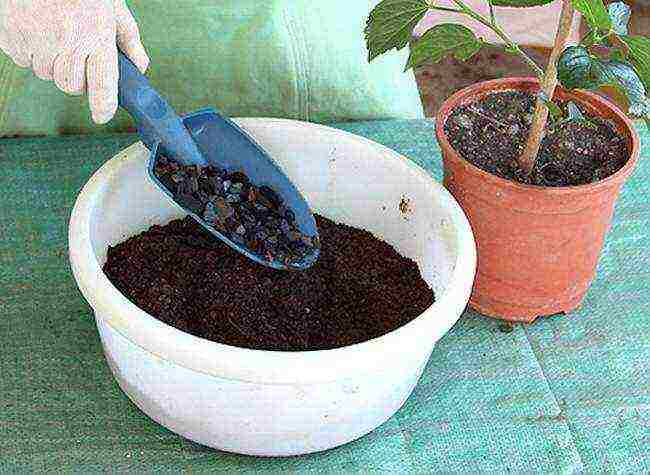
For growing hibiscus, an all-purpose potting potting mix is suitable. It is not recommended to use heavy, dense soil. The soil should be light, nutritious, give air access to the seeds.
If the wrong planting mixture is chosen, the fragile seeds will suffocate the plant. Seedling soil sold in gardening stores is also poorly suited.It doesn't have enough micronutrients. For self-preparation of the soil mixture, mix:
- Leaf humus - 2 parts;
- Perlite - 1 part.
This mixture is optimal, it allows you to grow hibiscus faster. At the bottom of the pot, you will need to place expanded clay of the finest grinding, the soil mixture takes ¾ of the volume of the container.
Planting capacity requirements
The Chinese rose is unpretentious, frost-resistant. The seeds are planted in standard cups or small pots per piece. The most important requirement for a container is the ability to pass liquid. It is impossible that water accumulates on the bottom of the container after watering, this leads to rotting of the seeds. Suitable container capacity is 0.5 l. Do not take pots that are too high, in which the hibiscus root system will not develop correctly.
Most specialty cups and pots have holes to drain excess liquid. If there are no holes in the container, you should make them yourself.
How to prepare seeds before planting
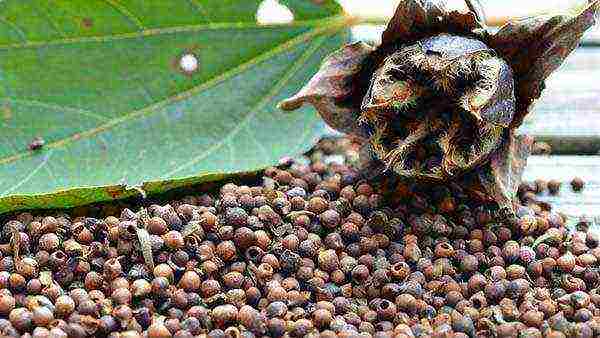
You can start preparing seeds at home in early March. Before planting, hibiscus seeds are subjected to the following manipulations:
- The right amount of grains is soaked in a nutritious growth promoter. For this, potassium humate, zircon is suitable. The seeds will spend several days in this state, before the first shoots appear. Stir the grains several times a day throughout the soak so that they receive nutrients from the entire surface. The soaking container must be flat, the liquid is filled 2/3 of the height.
- When the seeds germinate (after 3-4 days), you need to select the hatched grains and wrap them in damp gauze. The gauze is packed in a plastic bag. It will take another 2 days for the seeds to reach the desired state. As it dries, it is recommended to carefully moisten the gauze from a spray bottle.
Within a week of preparation, the hibiscus seeds will be completely ready for planting in the soil. Instead of gauze, you can use cotton pads or cotton cloth. Moisten the matter with warm, but not hot water.
Sowing hibiscus seeds
Seeds are planted 1 pc. in each glass. The soil mixture must be moistened before planting. For this, the soil is sprayed, mixed and sprayed again until the entire soil is moistened. The soil should not be strongly rammed, it must be loose, the seeds need air access. The seeds are buried to a depth of 5-6 cm, with the sprouted part on the side.
Conditions for germinating seeds
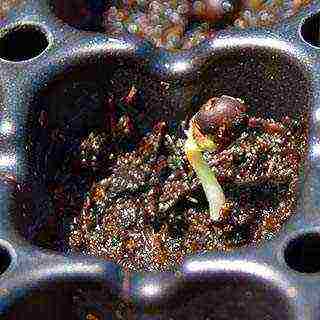 After placing the seeds in pots, they are covered with cling film or bags, placed in a warm place. The recommended temperature is +28 degrees. It is important that the room where the pots will stand is well lit. Once a day, the resulting greenhouse is ventilated - the polyethylene is removed for an hour. The soil should be constantly moist, but not too wet. It is recommended to spray the surface as it dries.
After placing the seeds in pots, they are covered with cling film or bags, placed in a warm place. The recommended temperature is +28 degrees. It is important that the room where the pots will stand is well lit. Once a day, the resulting greenhouse is ventilated - the polyethylene is removed for an hour. The soil should be constantly moist, but not too wet. It is recommended to spray the surface as it dries.
The emergence of shoots above ground level usually occurs 4-7 days after planting. When sprouts are found, the polyethylene is removed. During the first month of life, the plant should not be fed with hibiscus, the plant has enough trace elements in the soil mixture for full development.
Hibiscus seedling care
Hibiscus grown from seeds still needs care. Until the plant finally gets stronger, the sprouts should:
- Store in a well-lit area. In the shade, hibiscus grows poorly, often gets sick.
- Send out for a walk regularly. To do this, it is boring to put pots with sprouts on the balcony. As the Chinese rose warms and grows, the outdoor time increases. For the first time, the coolness is only a few minutes.
- Do not overdry, but do not moisturize too much. Watering the hibiscus too much should not be done, the stems of the plant easily get sick with black rot. It is best to continue to spray the soil around the flower.
- Monitor the temperature.The Chinese rose, native to Africa, prefers warmth, especially in the early stages of growth. The temperature in the room must not be less than 25 degrees Celsius.
Thanks to this simple care, the hibiscus will completely form from the sprout, and will not get sick or die.
Seedling picking
Picking - landing in a larger container. If the hibiscus was planted in pots with a volume of 0.5 liters and is intended for growth in indoor conditions, the pick can be skipped.
Some gardeners prefer to plant sprouted seeds in large boxes in bulk. Then a transplant will be required. A picking can be carried out no earlier than 14 days after the emergence of sprouts.
Further care
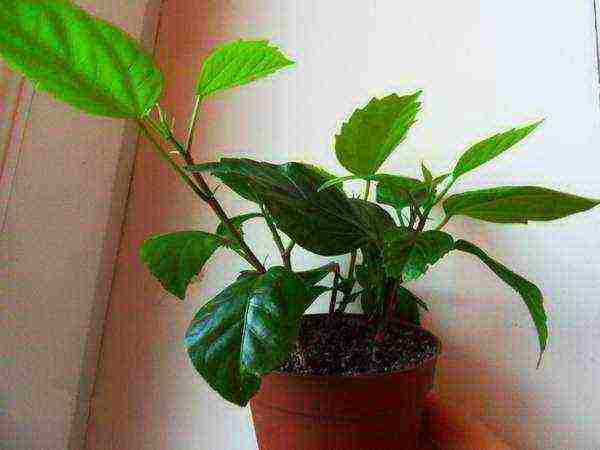
Hibiscus is unpretentious, when the seed germination process is over, caring for the plant comes down to the following:
- Gentle loosening of the soil to provide oxygen access to the root system;
- Removing weeds as they appear;
- Regular watering every 3-4 days;
- Top dressing with suitable liquid fertilizers every 2 weeks.
Starting in May, even indoor hibiscus can be planted outdoors until it gets cold. The Chinese rose thrives during the summer in garden conditions.

